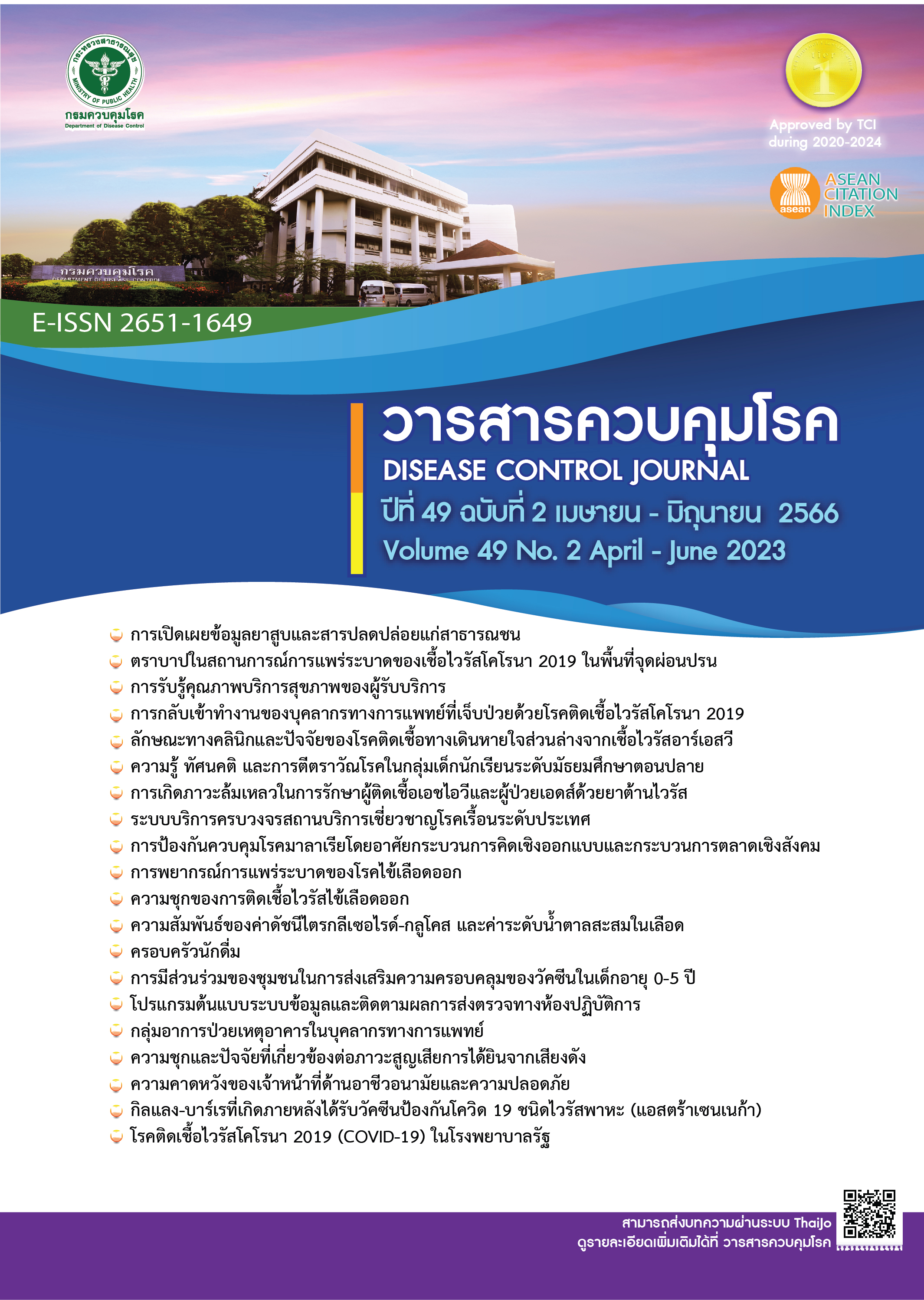The development of national leprosy specialized facility to provide comprehensive care
DOI:
https://doi.org/10.14456/dcj.2023.28Keywords:
leprosy, comprehensive care, leprosy node , national leprosy specialized facilityAbstract
The objective of this study was to develop national leprosy specialized facility in providing leprosy related comprehensive care. The study was divided into 4 phases: (i) situation analysis; (ii) developing the service system of comprehensive care; (iii) implementing pilot project; (iv) monitoring and evaluation. There were 51 subjects including 32 medical personnel and 19 leprosy patients. Duration of study was 2 years. Frequency and percentage were used in quantitative analysis. Triangular technique and content analysis were used to validate and analyze qualitative data. The study showed that the developed service system was a multidisciplinary service including counseling and referral for leprosy patients in cases where the leprosy network was unable to provide care. The results showed that (1) the medical personnel and leprosy patients accepted the system at a high level. (2) The medical personnel were satisfied and the leprosy patients were very satisfied with the system. (3) After developing the system, the treatment outcomes were better in terms of increasing the percentage of patients diagnosed at the first visit and reducing the incidence of severe complications related to treatment. One hundred percentage of high-risk leprosy patients were assessed nerve function and 100 percent of persons affected by leprosy were referred to get rehabilitation. From the results showed that the National Leprosy Specialized Facility improve the quality of health services for leprosy patients that suitable for the low prevalence of the disease in Thailand.
Downloads
References
Raj PrachaSamasai Institute (TH). Annual Report 2021 [Internet]. Samut Prakan. Raj PrachaSamasai Institute; 2021 [cited 2021 Oct 15]. 116 p. Available from: https://ddc.moph.go.th/uploads/publish/1282920220606095246.pdf (in Thai)
Sermrittirong S, Prompunjai N, Chua-Intra B. The Effectiveness Evaluation of Leprosy Specialized Facilities’ Development in 4 Regions of Thailand in 2018. Journal of Bamrasnaradura Infectious Diseases Institute [Internet]. 2019 [cited 2021 Oct 15];13(1):44-55. Available from: https://he01.tci-thaijo.org/index.php/bamrasjournal/article/view/186408/131020 (in Thai)
Rao P.S.S S. Referral system: A vital link in the sustainability of leprosy services. Leprosy Review [Internet]. 2010 [cited 2021 Oct 15];81(4):292-8. Available from: https://leprosyreview.org/article/81/4/29-2298
World Health Organization. Towards zero leprosy Global Leprosy (Hansen’s disease) Strategy 2021-2030 [Internet]. Geneva. World Health Organization; 2021 [cited 2021 Oct 15]. 30 p. Available from: https://www.who.int/publications/i/item/9789290228509
Kumar B, Kar HK. IAL Textbook of Leprosy. 2ndedition [Internet]. New Delhi. The Health Sciences Publisher; 2016. [cited 2021 Oct 15]. 774 p. Available from: https://www.amazon.com/Ial-Textbook-Leprosy-Bhushan-Kumar/dp/9351529916?asin=B09HK8HZ87&revisionId=&format=4&depth=1
Arquer GRd, Kumar A, Singh RK, Satle N, Mamidi R, Biswas P. COVID-19 and leprosy new case detection in India. Leprosy Review [Internet]. 2021 [cited 2021 Oct 15];92(1):88-91. Available from: https://leprosyreview.org/article/92/1/20-21008
Deps PD, Nasser S, Guerra P, Simon M, Birshner RDC, Rodrigues LC. Adverse effects from Multi-drug therapy in leprosy: A Brazilian study. Leprosy Review [Internet]. 2007 [cited 2021 Oct 15];78(3):216-22. Available from: https://leprosyreview.org/article/78/3/21 -6222
Vineetha M, Celine M, Sadeep MS, Kurien G. Adverse Reactions of Multi Drug Therapy of Leprosy- A Case Series. Indian Journal of Leprosy [Internet]. 2017 [cited 2021 Oct 15]; 89:165-71. Available from: https://www.ijl.org.in/published-articles/1409202114 1027/6_M_Vineeta_et_al_(165-171).pdf
Rathod SP, Jagati A, Chowdhary P. Disabilities in leprosy: an open, retrospective analyses of institutional records. An Bras Dermatol [Internet]. 2020 [cited 2021 Oct 15];95(1):52-6. Available from: https://reader.elsevier.com/reader/sd/pii/S036505961930176X?token=084D8BEB7C1C54A56C109E729A2DDF30F3D758E4987B331880098 126FB48DDFEB9F3951E074DAAF47DF472EFD8EEF55&originRegion=eu-west-1&originCreation= 20221209034337
Brakel WHv, Sihombing B, Djarir H, Beise K, Kusumawardhani L, Yulihane R, et al. Disability in people affected by leprosy: the role of impairment, activity, social participation, stigma and discrimination. Glob Health Action [Internet]. 2012 [cited 2021 Oct 15];5:18394:1-11. Available from: https://www.tandfonline.com/doi/epdf/10.3402/gha.v5i0.18394? needAccess=true&role=button
Pandey A, Rathod H. Integration of Leprosy into GHS in India: A Follow up study (2006-2007). Leprosy Review [Internet]. 2010 [cited 2021 Oct 15];81(4):306-17. Available from: https://leprosyreview.org/article/81/4/30-6317
Wijesinghe TS, Wijesinghe PR. Integration of leprosy services into the General Health Service in Sri Lanka: overcoming challenges to implementation in a remote district. WHO South-East Asia Journal of Public Health [Internet]. 2013 [cited 2021 Oct 15];2(1):63-7. Available from: https://apps.who.int/iris/bitstream/handle/10665/329773/seajphv2n1_p63.pdf?sequence=1&isAllowed=y
Barbieri RR, Sales AM, Hacker MA, Nery Nery JAdC, Duppre NC, Machado AdM, et al. Impact of a Reference Center on Leprosy Control under a Decentralized Public Health Care Policy in Brazil. PLOS Neglected Tropical Diseases. [Internet]. 2016 [cited 2021 Oct 15];10(10)e0005059:1-11. Available from: https://journals.plos.org/plosntds/article/file?id=10.1371/journal.pntd.0005059&type=printable
Downloads
Published
How to Cite
Issue
Section
License
Copyright (c) 2023 Disease Control Journal

This work is licensed under a Creative Commons Attribution-NonCommercial-NoDerivatives 4.0 International License.
Articles published in the Disease Control Journal are considered as academic work, research or analysis of the personal opinion of the authors, not the opinion of the Thailand Department of Disease Control or editorial team. The authors must be responsible for their articles.






